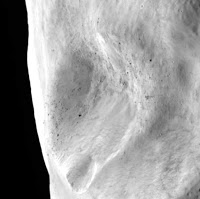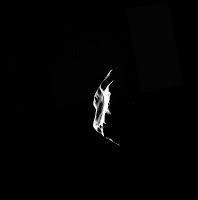Astronomy
ESA?s Rosetta mission successfully completed a flyby of asteroid Lutetia on July 10, capturing spectacular images of a remnant from the solar system?s creation. The spacecraft came as close as 3162 km, at a velocity of 15 km/s. At that velocity, the flyby did not last long (about a minute), but the craft was prepared with a variety of sensors to capture data before, during, and after the short flyby. Rosetta hunted for evidence of the presence of an atmosphere and magnetic effects, while studying the composition and density of the rocky body. The spacecraft even tried to capture and analyze grains of dust from the asteroid that may have been kicked into space around the asteroid. The results from these studies will be revealed at a later time.
Probably the most breathtaking of the rich information the Rosetta spacecraft captured from its flyby are the magnificent images of the rocky body. The craters and the surface of the asteroid are revealed in a stunning amount of detail, never before available to us. The images were especially breathtaking for me since I worked on researching asteroids for my high school senior project. Looking at just a tiny dot moving across a computer screen, I could never help but wonder what that tiny dot really is. What does it actually look like and what is it made of? Now looking at any asteroid, at what on Earth would appear as just a small dot indistinguishable from the hundreds of stars on an image, take on a definite and unique shape never ceases to blow me away.
My favorite image from Rosetta is the image of asteroid Lutetia captured alongside Saturn. It nicely frames one of the largest bodies in the solar system with one of the smallest.
The Rosetta mission itself was launched in 2004, and is headed towards comet 67P/Churyumov-Gerasimenko, with that encounter scheduled for 2014. It will orbit the comet and deploy a lander, studying its composition which will help us eventually understand more about comets and the early solar system. In fact, Rosetta?s name originates from that of the Rosetta Stone, since it is designed to unlock secrets about the solar system before the existence of planets, much like how the Rosetta Stone unlocked secrets about Egyptian hieroglyphics. Asteroid Lutetia is the second asteroid that the spacecraft has flown by on its way to the comet.
Additional images of Lutetia captured by Rosetta are included below. (Images: ESA)





P.S. This is my blog?s 100th post. Wow.
- See Asteroid Vesta With Your Naked Eyes
Mark the date 17 Feb, 2010 as you might see Asteroid Vesta with binoculars or if you are lucky can even see it with your naked eyes as it will shine at a magnitude of 6.1 . Vesta is not the largest asteroid but it will be brightest as it will be opposite...
- Rosetta Captures Stunning Picture Of The Earth
ESA's Rosetta spacecraft, as it is conducting its final flyby of the Earth, captured a very stunning picture of the planet, showing an illuminated crescent. The image was made by combining images taken through the orange, green, and blue filters by...
- Rosetta Have Found Oxygen On Comet 67p.
The European Space Agency's [ESA] Rosetta spacecraft has detected significant levels of molecular oxygen coming from Comet 67P/Churyumov-Gerasimenko in a discovery that has taken astronomers by surprise. Molecular oxygen has never been detected...
- Nasa Captures Earth Flyby Of 'space Peanut'
NASA scientists have captured a peanut-shaped asteroid that approached close to Earth last weekend. The asteroid named 1999 JD6 appears to be a contact binary [an asteroid with two lobes that are stuck together]. On July 25, the asteroid...
- The Rosetta Selfie.
The Rosetta spacecraft managed to take this picture before making history.A camera aboard ESA?s Philae lander snapped this 'Selfie' of one of the Rosetta's 52-foot-long [16-meter] solar arrays, with comet 67P/Churyumov?Gerasimenko hovering...
Astronomy
Rosetta's Closeup with Asteroid Lutetia
 |
| Asteroid Lutetia, captured by Rosetta Image: ESA |
ESA?s Rosetta mission successfully completed a flyby of asteroid Lutetia on July 10, capturing spectacular images of a remnant from the solar system?s creation. The spacecraft came as close as 3162 km, at a velocity of 15 km/s. At that velocity, the flyby did not last long (about a minute), but the craft was prepared with a variety of sensors to capture data before, during, and after the short flyby. Rosetta hunted for evidence of the presence of an atmosphere and magnetic effects, while studying the composition and density of the rocky body. The spacecraft even tried to capture and analyze grains of dust from the asteroid that may have been kicked into space around the asteroid. The results from these studies will be revealed at a later time.
Probably the most breathtaking of the rich information the Rosetta spacecraft captured from its flyby are the magnificent images of the rocky body. The craters and the surface of the asteroid are revealed in a stunning amount of detail, never before available to us. The images were especially breathtaking for me since I worked on researching asteroids for my high school senior project. Looking at just a tiny dot moving across a computer screen, I could never help but wonder what that tiny dot really is. What does it actually look like and what is it made of? Now looking at any asteroid, at what on Earth would appear as just a small dot indistinguishable from the hundreds of stars on an image, take on a definite and unique shape never ceases to blow me away.
 |
| Asteroid Lutetia with Saturn Image: ESA |
The Rosetta mission itself was launched in 2004, and is headed towards comet 67P/Churyumov-Gerasimenko, with that encounter scheduled for 2014. It will orbit the comet and deploy a lander, studying its composition which will help us eventually understand more about comets and the early solar system. In fact, Rosetta?s name originates from that of the Rosetta Stone, since it is designed to unlock secrets about the solar system before the existence of planets, much like how the Rosetta Stone unlocked secrets about Egyptian hieroglyphics. Asteroid Lutetia is the second asteroid that the spacecraft has flown by on its way to the comet.
Additional images of Lutetia captured by Rosetta are included below. (Images: ESA)





P.S. This is my blog?s 100th post. Wow.
- See Asteroid Vesta With Your Naked Eyes
Mark the date 17 Feb, 2010 as you might see Asteroid Vesta with binoculars or if you are lucky can even see it with your naked eyes as it will shine at a magnitude of 6.1 . Vesta is not the largest asteroid but it will be brightest as it will be opposite...
- Rosetta Captures Stunning Picture Of The Earth
ESA's Rosetta spacecraft, as it is conducting its final flyby of the Earth, captured a very stunning picture of the planet, showing an illuminated crescent. The image was made by combining images taken through the orange, green, and blue filters by...
- Rosetta Have Found Oxygen On Comet 67p.
The European Space Agency's [ESA] Rosetta spacecraft has detected significant levels of molecular oxygen coming from Comet 67P/Churyumov-Gerasimenko in a discovery that has taken astronomers by surprise. Molecular oxygen has never been detected...
- Nasa Captures Earth Flyby Of 'space Peanut'
NASA scientists have captured a peanut-shaped asteroid that approached close to Earth last weekend. The asteroid named 1999 JD6 appears to be a contact binary [an asteroid with two lobes that are stuck together]. On July 25, the asteroid...
- The Rosetta Selfie.
The Rosetta spacecraft managed to take this picture before making history.A camera aboard ESA?s Philae lander snapped this 'Selfie' of one of the Rosetta's 52-foot-long [16-meter] solar arrays, with comet 67P/Churyumov?Gerasimenko hovering...
